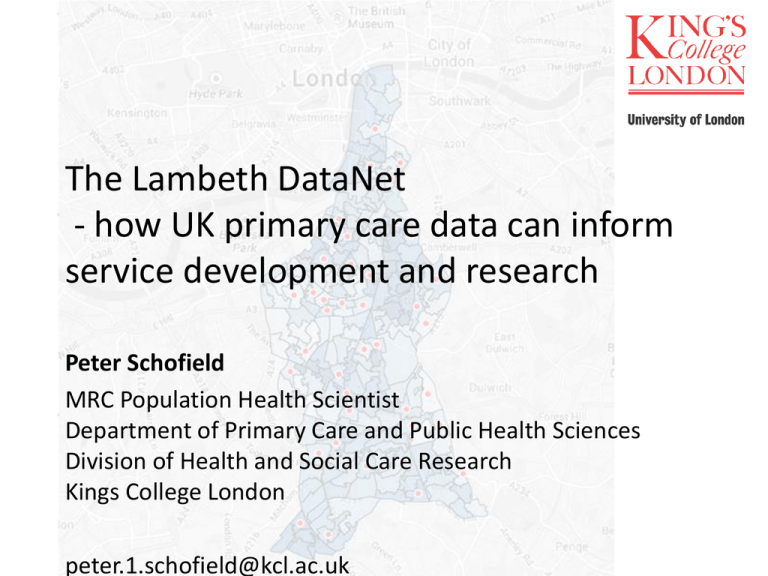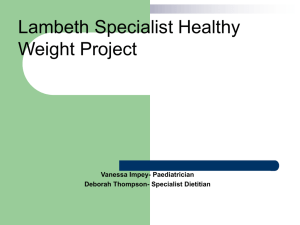Peter Schofield
advertisement

The Lambeth DataNet - how UK primary care data can inform service development and research Peter Schofield MRC Population Health Scientist Department of Primary Care and Public Health Sciences Division of Health and Social Care Research Kings College London peter.1.schofield@kcl.ac.uk The unique benefits of UK primary care data • Universal health care -> free at the point of use • National Institute for Health & Care Excellence (NICE) guidelines -> ensure standardised treatment • Quality and Outcomes Framework (QOF) - national incentive scheme -> standardised data collected • Primary care –> first point of access • -> GP holds central care record for each patient • National data – QOF register -> national data at practice level – CPRD, THIN, QRESEARCH -> national data at patient (sample) level • Local data – Small number of schemes -> comprehensive local data at patient level Clapham Common Brixton Market Socioeconomic diversity in Lambeth Deprivation scale Most deprived Least deprived Lambeth is the 19th most deprived (of 354 local authorities in England) Ethnic diversity in Lambeth Proportion nonwhite British Lambeth has the 2nd highest proportion of Black residents in the UK (25.8%) The Lambeth DataNet GP records and patient profile data covering Lambeth GP practices What socio-demographic information do we have? • • • • • Residential area (detailed): 99.9% of patients Ethnicity (census - 16 categories): 81% Main language spoken: 73% Country of birth: 56% Religion: 47% What clinical information do we have? • • • • Potentially anything coded by the GP: i.e. diagnoses, test results, prescribing .. QOF indicators are particularly reliable Can be linked with secondary care (hospital records, psychiatric records) Also linked to area level data (e.g. census, area deprivation etc.. ) How is the data collected? • Previously extracted from practice computer systems using MIQUEST software – required specialist expertise to run queries • Currently extracted centrally using EMIS Web – easier to run queries on the data – potential to update and interrogate dataset in real time When is this data collected? • Typically we have obtained a new extraction annually • Can now analyse longitudinally patient records going back to 2008 How much data do we have? • Currently all patient records for 51/52 GP practices in Lambeth • Approximately 350,000 patients in total Who owns the data? • Ultimately the data is owned by Lambeth GPs • Responsibility for approving research and organising the extractions is delegated to the DataNet steering group Socio-demographic profile* Encrypted ID “Read” codes *data here is fictitious but in the same format as original records Clinical record* *data here is fictitious but in the same format as original records Why is this useful for research? - Lambeth is well placed for research into ethnic and socio-economic inequalities - Typically better socio-demographic information compared to national data - Larger sample of non-white ethnic groups than other national datasets - i.e. national survey data / national health records datasets - Local data -> allows analysis in context - Whole population data => Includes information about healthy controls - Studies so far Ethnic inequalities in blood pressure control Marked ethnic inequalities were found, with black patients significantly less likely to achieve BP targets than white (OR 0.73). Once ethnicity was accounted for social deprivation made little or no difference. Ethnic inequalities in the treatment of hypertension National guidelines recommending specific therapy for hypertension management often ignored. Applies to both black and white patients equally. Cardiovascular Risk Scores We compared the results of four different CVD prediction scores: FRAMINGHAM, QRISK2, ASSIGN and ETHRISK. We found all except Q-RISK2 over-predicted risk for the black population. Ethnicity and stroke risk in patients with atrial fibrillation Stroke risk is higher among South Asians with AF. Under-prescription of anticoagulants persists in all ethnic groups. Ethnic differences in the management of patients with psychosis No ethnic differences in physical health care BUT Black patients > 2 x likely to be on depot anti-psychotics. Ethnic isolation and ethnic inequality in risk of psychosis Controlling for deprivation, Black people in high own ethnic density areas showed no difference in psychosis rates but in low ethnic density areas were at significantly greater risk. Predictors of first episode psychosis for black population in Lambeth Ethnic Density 1 1st quintile (most dense) 2nd quintile 3rd quintile 4th quintile 5th quintile (least dense) IRR 1.00 2.50** 3.59*** 5.39*** 5.24** 95% CI (1.37-4.58) (1.87-7.00) (2.48-11.69) (1.95-14.07) Analysis at lower super output area (LSOA) level –approx. 1,500 people Much smaller effect size shown at (typically used) middle SOA level – approx. 7,500 people Ethnic density and rates of first episode psychosis for black population in Lambeth 6 5 4 3 2 1 0 1st quintile 2nd - most quintile dense 3rd quintile 4th quintile 5th quintile least dense Current follow up study Revisit ethnic density analysis using: 1) Lambeth DataNet linked with psychiatric data – to validate and enhance primary care mental health data 2) Data pooled with similar primary care data collected for East London practices Other current projects using similar linked data • Location of care for people with severe mental illness: implications for service use and costs – Investigating the shift from secondary to primary care for severe mental illness using Lambeth DataNet linked to psychiatric records • Mental & physical health in Lambeth – Investigating physical health care of people with severe mental illness using linked data Other projects • Effect of multi-morbidity on blood pressure control – also using data pooled with health records from East London • Ethnic inequalities in smoking and COPD rates Data Governance • Ethical approval NHS ethics committees now treat secondary data analysis as audit => ethical approval usually not required • Local governance approval BUT obtaining local approval for data sharing can be a challenge: • Care.data Recent attempt to introduce a comprehensive national patient records research dataset -> public outcry over potential for data sharing abuses now much more difficult to obtain local data sharing approval • NHS re-organisation Local Primary Care Trusts (PCTs) recently disbanded -> approval process now being re-organised • Data Linkage approval Currently difficult to obtain for sensitive data Relies on “accredited safe haven” Lambeth DataNet and Audit Identify inequalities • e.g. under-diagnosed diabetes in black community Identify unmet needs • e.g. under-use of anti-coagulants in AF Apply targeted interventions Inform re-design of services Public health reports feeding back individual practice performance in key clinical areas: • Hypertension • Atrial fibrillation • Diabetes • Dementia • Severe mental illness • Depression • Use of Psychological Therapies Summary • The UK is uniquely well placed to provide electronic health records for audit & research • Local data enables whole population studies in context • Lambeth DataNet is a particularly valuable resource for research into ethnic inequalities • Data linkage has enabled a range of studies examining the interface between primary and secondary care • Obtaining local governance approval can be a challenge • Local data facilitates local audit Lambeth DataNet Publications Mathur, R., E. Pollara, S. Hull, P. Schofield, M. Ashworth and J. Robson (2013). Ethnicity and stroke risk in patients with atrial fibrillation. Heart. Schofield P, Crichton N, Chen R (2012) Methods for assessing cardiovascular disease risk in a UK black population. Heart. Schofield P, Baawuah F, Seed P, Ashworth M. (2012) Managing hypertension in general practice: a cross sectional study of treatment and ethnicity. British Journal of General Practice Schofield P, Ashworth M, Jones R (2011) Ethnic isolation and psychosis: re-examining the ethnic density effect. Psychological Medicine Schofield P, Saka O, Ashworth M., (2011) Ethnic differences in blood pressure monitoring and control in Lambeth British Journal of General Practice. Pinto, R., M. Ashworth, P. Seed, G. Rowlands, P. Schofield, R. Jones (2010) Differences in the primary care management of patients with psychosis from two ethnic groups: a population based cross-sectional study. Family Practice. Kumarapeli, P., R. Stepaniuk, S. de Lusignan, R. Williams and G. Rowlands (2006). Ethnicity recording in general practice computer systems. Journal of Public Health







